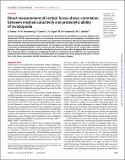Files in this item
Direct measurement of vertical forces shows correlation between mechanical activity and proteolytic ability of invadopodia
Item metadata
| dc.contributor.author | Dalaka, Eleni | |
| dc.contributor.author | Kronenberg, Nils Michael | |
| dc.contributor.author | Liehm, Philipp | |
| dc.contributor.author | Segall, J.E. | |
| dc.contributor.author | Prystowsky, M.B. | |
| dc.contributor.author | Gather, Malte Christian | |
| dc.date.accessioned | 2020-03-30T10:30:01Z | |
| dc.date.available | 2020-03-30T10:30:01Z | |
| dc.date.issued | 2020-03-11 | |
| dc.identifier | 263958218 | |
| dc.identifier | 9d89c3e3-ad88-43da-9b6c-7b3fd7b9839b | |
| dc.identifier | 85082027625 | |
| dc.identifier | 000520866800005 | |
| dc.identifier.citation | Dalaka , E , Kronenberg , N M , Liehm , P , Segall , J E , Prystowsky , M B & Gather , M C 2020 , ' Direct measurement of vertical forces shows correlation between mechanical activity and proteolytic ability of invadopodia ' , Science Advances , vol. 6 , no. 11 , eaax6912 . https://doi.org/10.1126/sciadv.aax6912 | en |
| dc.identifier.issn | 2375-2548 | |
| dc.identifier.other | ORCID: /0000-0002-4857-5562/work/71559948 | |
| dc.identifier.other | ORCID: /0000-0003-3306-7466/work/71560001 | |
| dc.identifier.uri | https://hdl.handle.net/10023/19728 | |
| dc.description | Funding: European Research Council under the European Union’s Horizon 2020 Framework Programme (ERC StG ABLASE, 640012); BBSRC (BB/P027148/1); EPSRC Programme Grant (EP/P030017/1); EPSRC Doctoral Training Partnership (EP/N509759/1, EP/L505079/1). | en |
| dc.description.abstract | Mechanobiology plays a prominent role in cancer invasion and metastasis. The ability of a cancer to degrade extracellular matrix (ECM) is likely connected to its invasiveness. Many cancer cells form invadopodia—micrometer-sized cellular protrusions that promote invasion through matrix degradation (proteolysis). Although it has been hypothesized that invadopodia exert mechanical force that is implicated in cancer invasion, direct measurements remain elusive. Here, we use a recently developed interferometric force imaging technique that provides piconewton resolution to quantify invadopodial forces in cells of head and neck squamous carcinoma and to monitor their temporal dynamics. We compare the force exerted by individual protrusions to their ability to degrade ECM and investigate the mechanical effects of inhibiting invadopodia through overexpression of microRNA-375. By connecting the biophysical and biochemical characteristics of invadopodia, our study provides a new perspective on cancer invasion that, in the future, may help to identify biomechanical targets for cancer therapy. | |
| dc.format.extent | 9 | |
| dc.format.extent | 2254867 | |
| dc.language.iso | eng | |
| dc.relation.ispartof | Science Advances | en |
| dc.subject | QC Physics | en |
| dc.subject | QH301 Biology | en |
| dc.subject | RC0254 Neoplasms. Tumors. Oncology (including Cancer) | en |
| dc.subject | DAS | en |
| dc.subject | SDG 3 - Good Health and Well-being | en |
| dc.subject.lcc | QC | en |
| dc.subject.lcc | QH301 | en |
| dc.subject.lcc | RC0254 | en |
| dc.title | Direct measurement of vertical forces shows correlation between mechanical activity and proteolytic ability of invadopodia | en |
| dc.type | Journal article | en |
| dc.contributor.sponsor | European Research Council | en |
| dc.contributor.sponsor | BBSRC | en |
| dc.contributor.sponsor | EPSRC | en |
| dc.contributor.institution | University of St Andrews. School of Physics and Astronomy | en |
| dc.contributor.institution | University of St Andrews. Sir James Mackenzie Institute for Early Diagnosis | en |
| dc.contributor.institution | University of St Andrews. Centre for Biophotonics | en |
| dc.contributor.institution | University of St Andrews. Biomedical Sciences Research Complex | en |
| dc.identifier.doi | https://doi.org/10.1126/sciadv.aax6912 | |
| dc.description.status | Peer reviewed | en |
| dc.identifier.grantnumber | 640012 | en |
| dc.identifier.grantnumber | BB/P027148/1 | en |
| dc.identifier.grantnumber | EP/P030017/1 | en |
This item appears in the following Collection(s)
Items in the St Andrews Research Repository are protected by copyright, with all rights reserved, unless otherwise indicated.

